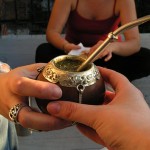The Rite of Mate

What do you get when you combine a hollowed-out gourd, a bombilla (or straw), a mix of leaves and twigs steeped in hot water and a couple of amigos? Well, the ultimate mate drinking experience, of course! For those of you who don’t already know, mate, also known as yerba mate, is a traditional drink consumed in South America, particularly Argentina, Uruguay, Paraguay and the southern states of Brazil, and to a smaller degree in the south of Chile and the Chaco region of Bolivia. In these regions you can observe natives slurping the pungent tea-like concoction in practically any setting, whether it be during daily commutes, with friends at the park on a sunny day, or during break time with classmates and work colleagues. Just about as ubiquitous as coffee—and packing just about as much caffeine—mate isn’t just a drink, it’s truly a cultural bastion in its own right, bringing people together to share in quality conversation and a satisfying communal beverage.
But where did the name mate come from? Nowadays people will colloquially use the word mate in both Portuguese and Spanish to refer to both the mate plant and beverage alike; however, the word doesn’t actually originate from either language. Mate is in fact a linguistic adaptation of the word mati, which comes from Quechua (the most widely spoken indigenous language in the Americas). In Quechua mati has several meanings that include: herb infusion, gourd, and container for a drink. Interestingly enough though, mate was actually first cultivated and consumed by the indigenous Guaraní and Tupi people of Paraguay and southern Brazil, respectively. As such, mate was actually first known as ka’a, or “herb” in Guaraní, and kõ’gõi in Tupi which can be translated as, “what sustains the being.”
Somewhat bitter and pungent, for many, mate is an acquired taste that takes some getting used to. Despite its bold flavor, today the yerba mate can be prepared in a variety of ways to suit different tastes. The most popular of these preparation methods is either straight-up or with sugar/sweetener combined with scalding-hot water, which regardless of the temperature outside, many thermos-toting drinkers opt for year-round. Other drinkers, however, especially during the warmer months, enjoy a more refreshing spin on the classic beverage, known as tereré (in Spanish) or tererê (in Portuguese). Tereré is consumed cold and usually with a twist of citrus juice (for any of you from the southeastern United States, think a fruit-flavored sweet tea of sorts!). In case you are now anxious to experience mate for yourself, try snagging some in the international aisle at your local organic or specialty grocer today!
And just as mate is a very regional beverage, Trusted Translations can help you with your regional language localization needs. Contact us today for a free quote!
